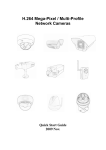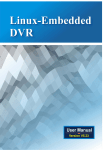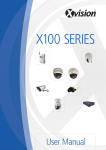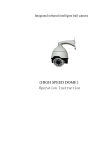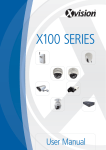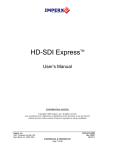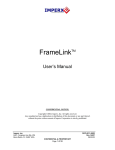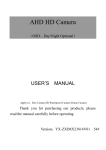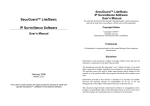Download User Manuals
Transcript
SecuGuard Basic 6.0 User’s manual April. 2011 Version: 6.0.3.xxx SecuGuard Basic System Requirement ............................................................................................. 6 Installation ............................................................................................................. 7 Before Installing the Software ............................................................................................. 7 Starting the Installation ........................................................................................................ 7 Quick Start ........................................................................................................... 10 Install IP Camera(s) ........................................................................................................... 10 Add IP Camera(s)............................................................................................................... 10 Configuration of schedule recording: ............................................................................................................ 14 Playback: ....................................................................................................................................................... 20 1. Main-console .................................................................................................... 24 1.1 System status:............................................................................................................... 25 1.2 Screen Division: ........................................................................................................... 27 1.3 DI/O status: .................................................................................................................. 28 1.4 Operation with sub-screen: .......................................................................................... 29 1.4.1 Define display camera(s) sequence:...................................................................................................... 29 1.4.2 Digital Zoom at sub-screen: ................................................................................................................. 29 1.4.3 Switch to Full screen: ........................................................................................................................... 30 1.4.4 Snapshot of sub-screen: ........................................................................................................................ 30 1.4.5 Restore quad default: ............................................................................................................................ 31 1.5 System setup: ............................................................................................................... 32 1.5.1 System page at System setup dialog: .................................................................................................... 32 1.5.1.1 Start up configuration: ........................................................................................................... 33 1.5.1.2 Language configuration: .......................................................................................................... 33 1.5.1.3 Auto scan: ................................................................................................................................ 33 1.5.1.4 Storage configuration: ............................................................................................................. 34 1.5.1.5 System status: ........................................................................................................................ 34 1.5.1.6 HDD status: ................................................................................................................... 35 1.5.1.7 NxN Division: ......................................................................................................................... 35 1.5.2 Camera page at System setup dialog: ................................................................................................... 35 1.5.2.1 Camera list:.............................................................................................................................. 36 1.5.2.2 OSD Configuration: ................................................................................................................. 36 1.5.2.3 Camera Configuration: ............................................................................................................ 37 1.5.2.4 Search Page: ............................................................................................................................ 38 1.5.2.5.1 Channel parameter Page(general): ........................................................................................ 39 1.5.2.5.2 Channel parameter Page(NVR): ........................................................................................... 41 1.5.3 User page at System setup dialog: ........................................................................................................ 41 1.5.3.1 User Privilege: ......................................................................................................................... 42 1 SecuGuard Basic 1.5.3.2 Account list: ............................................................................................................................ 43 1.5.3.3 User configuration: .................................................................................................................. 43 1.5.4 Address Book page at System setup dialog: ......................................................................................... 45 1.5.5 Notification page at System setup dialog: ............................................................................................ 46 1.5.5.1 SMTP Setting: ......................................................................................................................... 46 1.5.5.2 Mail Content: ........................................................................................................................... 47 1.5.5.3 Alarm Setting: ......................................................................................................................... 47 1.5.5.4 FTP Config: ............................................................................................................................. 48 1.5.5.5 Send to Config: ........................................................................................................................ 48 1.5.6 Muti-Monitor at System setup dialog: .................................................................................................. 49 1.5.7 Joystick at System setup dialog: ........................................................................................................... 50 1.6 Schedule setup: ............................................................................................................ 52 1.6.1 Schedule mode: .................................................................................................................................... 53 1.6.2 Select camera of Daily mode: ............................................................................................................... 53 1.6.3 Select weekday of Weekly mode: ......................................................................................................... 54 1.6.4 Select camera of special day mode: ...................................................................................................... 55 1.6.5 Add or remove special day: .................................................................................................................. 56 1.6.6 Add schedule time slice: ....................................................................................................................... 56 1.6.7 Modify schedule time slice: .................................................................................................................. 57 1.6.8 Remove schedule time slice: ................................................................................................................ 57 1.6.9 Record Setup Page:............................................................................................................................... 58 1.6.10 Record Mode: ..................................................................................................................................... 58 1.6.11 Record Setting: ................................................................................................................................... 59 1.6.12 Motion Configuration: ........................................................................................................................ 59 1.6.13 DI Record Setting: ............................................................................................................................ 60 1.6.14 Complete Schedule Setting: ................................................................................................................ 60 1.7 Start & Stop Monitor: .................................................................................................. 61 1.7.1 Alarm Event Report:............................................................................................................................. 62 1.8 E-Map: ......................................................................................................................... 63 1.8.1 Camera list: .......................................................................................................................................... 64 1.8.2 Add camera to Map: ............................................................................................................................. 64 1.8.3 Make camera as a focus camera: .......................................................................................................... 64 1.8.4 Move camera on Map: .......................................................................................................................... 64 1.8.5 Rotate camera on Map: ......................................................................................................................... 64 1.8.6 Delete camera on Map: ......................................................................................................................... 64 1.8.7 Change Map: ........................................................................................................................................ 64 1.9 Two way Audio: ........................................................................................................... 65 1.10 PTZ control: ............................................................................................................... 66 2 SecuGuard Basic 1.10.1 Speed control: ..................................................................................................................................... 66 1.10.2 Direction control:................................................................................................................................ 66 1.10.3 Tour control: ....................................................................................................................................... 67 1.10.4 Preset control: ..................................................................................................................................... 67 1.10.5 Auto pan control: ................................................................................................................................ 67 1.10.6 Zoom control: ..................................................................................................................................... 67 1.10.7 Focus control: ..................................................................................................................................... 68 1.10.8 IRIS control: ....................................................................................................................................... 68 1.11 Alarm Setting: ............................................................................................................ 69 1.11.1 Event Setting / Add Event: ................................................................................................................. 69 1.11.2 Event Setting / Edit Event: ................................................................................................................. 70 1.11.2.1 Event Setting/ Edit Event / Basic Setting: ............................................................................. 71 1.11.2.2 Event Setting/ Edit Event / Advance Setting/ Motion: .......................................................... 72 1.11.2.3 Event Setting/ Edit Event / Advance Setting/ Digital Input: .................................................. 72 1.11.2.4 Event Setting/ Edit Event / Advance Setting/ Block Detect: ................................................. 73 1.11.2.5 Event Setting/ Edit Event / Advance Setting/ Blur Detect: .................................................... 73 1.11.2.6 Event Setting/ Edit Event / Advance Setting/ Camera Move Detect: .................................... 73 1.11.3 Event Setting / Delete Event: .............................................................................................................. 73 1.11.4 Event Setting / Add Action:................................................................................................................ 74 1.11.5 Event Setting / Edit Action: ................................................................................................................ 74 1.11.5.1 Event Setting/ Edit Action / Display on image: ..................................................................... 75 1.11.5.2 Event Setting/ Edit Action / Send Mail: ................................................................................ 75 1.11.5.3 Event Setting/ Edit Action / Play Alarm sound: .................................................................... 75 1.11.5.4 Event Setting/ Edit Action / Trigger Digital Output: ............................................................. 76 1.11.5.4 Event Setting/ Edit Action / Upload to FTP: ......................................................................... 76 1.11.6 Event Setting / Delete Action: ............................................................................................................ 76 1.11.7 Event Setting / Clone Event setting: ................................................................................................... 76 1.12 Server Setup: .............................................................................................................. 77 1.12.1 Autorun Server: .................................................................................................................................. 77 1.12.2 Start Server: ........................................................................................................................................ 77 1.12.3 Stop Server: ........................................................................................................................................ 77 1.12.4 HTTP Port: ......................................................................................................................................... 78 1.12.4 RTSP Port: .......................................................................................................................................... 78 1.12.5 Remote Playback Port: ....................................................................................................................... 78 1.13 Log Viewer:................................................................................................................ 78 1.14 Import / Export Setting: ............................................................................................. 81 2. Playback ........................................................................................................... 82 2.1 Search history recorded file(s): .................................................................................... 83 3 SecuGuard Basic 2.1.1 Search history file(s) dialog: ................................................................................................................. 83 2.1.2 Select a day to search history file(s): .................................................................................................... 84 2.1.3 Select record mode(s) / Event Type: .................................................................................................... 84 2.1.4 Start search: .......................................................................................................................................... 84 2.1.5 Review history record file(s) in search period: ..................................................................................... 84 2.1.6 Assign time period of search result: ..................................................................................................... 85 2.1.7 Select the camera(s) to playback: ......................................................................................................... 85 2.1.8 Start playback history file(s):................................................................................................................ 85 2.2 Playback control button(s): .......................................................................................... 86 2.2.1 Play button: .................................................................................................................................. 86 2.2.2 Pause button: ................................................................................................................................ 86 2.2.3 Backward play button: 2.2.4 Stop button: ................................................................................................................. 86 .................................................................................................................................. 86 2.2.5 Next frame button: ....................................................................................................................... 86 2.2.6 Previous frame button: ................................................................................................................. 86 2.2.7 Playback speed control: ................................................................................................................ 87 2.2.8 Division control buttons: ...................................................................................................................... 87 2.3 Convert to AVI file: ...................................................................................................... 88 2.3.1 Convert file dialog: ............................................................................................................................... 88 2.3.2 Select a day to covert history file(s): .................................................................................................... 89 2.3.3 Assign time slice to convert job: .......................................................................................................... 89 2.3.4 Select cameras to convert job: .............................................................................................................. 89 2.3.5 Select a folder to save converted file: ................................................................................................... 89 2.3.6 Start converting job: ............................................................................................................................. 89 2.4 Switch audio play mode: .............................................................................................. 90 2.5 Playback setting: .......................................................................................................... 90 2.6 Snapshot dialog: ........................................................................................................... 90 2.6.1 Snapshot all dialog: .............................................................................................................................. 91 2.6.2 Select snapshot image:.......................................................................................................................... 91 2.6.3 Select snapshot folder: .......................................................................................................................... 92 2.6.4 Select file format: ................................................................................................................................. 92 2.6.5 Save snapshot images: .......................................................................................................................... 92 2.6.6 Saved image file name: ........................................................................................................................ 92 2.7 Backup history file(s):.................................................................................................. 93 2.7.1 Backup dialog: ...................................................................................................................................... 93 2.7.2 Select date and time of backup slice:.................................................................................................... 93 2.7.3 Select backup camera(s) and backup time period: ................................................................................ 93 2.7.4 Select output directory: ......................................................................................................................... 93 4 SecuGuard Basic 2.7.5 Start backup job: ................................................................................................................................... 93 2.7.6 Playback backup files: .......................................................................................................................... 94 2.8 Playback status: ............................................................................................................ 94 2.9 Operation with sub-screen: .......................................................................................... 95 2.9.1 Define display camera(s) sequence:...................................................................................................... 95 2.9.2 Digital Zoom at sub-screen: ................................................................................................................. 95 2.9.3 Switch to Full screen: ........................................................................................................................... 96 2.9.4 Snapshot of sub-screen: ........................................................................................................................ 96 2.9.5 Motion Search: ..................................................................................................................................... 97 2.9.6 Sequential Search: ................................................................................................................................ 98 2.9.6.1 Define search time period: ....................................................................................................... 99 2.9.6.2 Start search and rollback: ...................................................................................................... 100 2.9.6.3 Detail window for snapshots: ................................................................................................ 100 2.9.6.4 Preview mode of search result: .............................................................................................. 101 3. Remote Service .............................................................................................. 102 3.1 Installation: ................................................................................................................ 102 3.2 Login: ......................................................................................................................... 102 3.3 Setting synchronization:............................................................................................. 103 3.4 Select preview live channels: ..................................................................................... 103 3.5 Operation with main page / Playback: ....................................................................... 104 3.6 Dissimilar with local: ................................................................................................. 104 3.6.1 Camera setup page:............................................................................................................................. 104 3.6.2 System setup page: ............................................................................................................................. 105 3.6.3 Notification setup page: ...................................................................................................................... 105 3.6.4 EMap: ................................................................................................................................................. 105 3.6.5 Alarm setup / Action setup / Play alarm sound: ................................................................................. 106 3.6.6 Event trigger alarm sound action: ....................................................................................................... 106 3.6.7 Remote service doesn’t support Joystick: ........................................................................................ 106 3.6.8 Remote service doesn’t support Import / Export setting: ................................................................. 106 3.6 Windows IE Protected mode :.................................................................................... 107 4. Repair database ............................................................................................. 108 4.1 Repair database status: ............................................................................................... 109 5. Un-install ........................................................................................................ 110 5 SecuGuard Basic System Requirement FPS (QVGA) ~120 120~360 360~540 540~960 960~ CPU Intel P4 2.4GHz Intel P4 3.2GHz Intel Pentium D 950 3.4GHZ Intel core 2 Duo Intel core I7 E8600 2600K 3.3GHZ 3.8GHZ RAM 512MB 512MB 1GB 2GB Display OS Support1024x768 resolution or above Support DirectX 9.0c or above Intel 945G or Intel 965G or above Windows XP,Vista*, Win 7 (32bits or 64bits) Hard disk Ethernet Chipset 4GB 60GB 100Mbps 1Gbps Intel 945 or Intel 965 or above * If you install the SecuGuard with the Vista, you should install more physical memory into system. QVGA = 320 x 240 pixel CIF ≒ QVGA , D1 ≒ VGA at mapping table below. Image resolution mapping table Resolution Compared with QVGA QQVGA QQVGA = QVGA / 4 VGA VGA = QVGA x 4 SXGA SXGA = QVGA x 16 FULL HD FHD = QVGA X 24 6 SecuGuard Basic Installation Installation Before Installing the Software 1. Make sure your PC has installed DirectX 9.0c or above. 2. Run SecuGuard5xxx.exe, which is included in the enclosed Software CD. Starting the Installation Step 1. The Installation Wizard will start. Select your preferred language for the SecuGuard. Step 2. The License Agreement window will be listed as belowt. Click “I Agree” to continue if you want to install this software. 7 SecuGuard Basic Installation Step 3. Select the “SecuGuard Basic” , then click Next button. Step 4. The Choose Destination Location window will open next. Select the folder which you wish to intall SecuGuard Basic to, and then click on Install button to continue. 8 SecuGuard Basic Installation Step 5. The Installation Wizard Complete window will open next. Click on Close button to complete the installation. 9 SecuGuard Basic Quick Start Quick Start Install IP Camera(s) Step 1 : Setup the IP camera(s) following by the instruction manual provided by the manufacturer. Step 2 : Check the network between the IP camera(s) and the system. Step 3 : Add the IP camera(s) to the system following steps as below. Add IP Camera(s) Step 1 : Click the Start → All Programs → SecuGuard_Basic_5.0 → SecuGuard. Step 2 : Key-in User name and password to login SecuGuard (The default of user name is “admin” without password) Checked the “Remember User” then login system, next time, will auto set the username by login account this time. 10 SecuGuard Basic Quick Start Step 3 : Click System setup Step 4 : Select Camera page and key-in camera’s configuration, then click “Add” button. 11 SecuGuard Basic Quick Start Camera configuration: Click “Auto Detect” button to detect camera, system will check and set model automatically. Please confirm the “Vendor” and “Model” setting is matched to the camera, or may cause the camera not functional properly. If you need to change the Camera Parameters, click button. Select the Video codec, Resolution, protocol, and streaming port for the current connection. Checked the “Enable Audio” if you need to receive Audio streaming. If you need to record audio into file, you must checked “Enable Audio” and “Enable Audio Record” both. 12 SecuGuard Basic Quick Start Step 5 : Click the “Search” button to search the camera(s) installed in LAN, waiting for searching complete then select the cameras as your need, and click “OK” button to finish this job. Step 6 : Confirm all added camera’s setting parameter. Step 7 : Click “OK” button. Step 8 : Now you can preview live stream at main page. 13 SecuGuard Basic Quick Start Configuration of schedule recording: Step 1 : Click “Schedule Setup” button. Step 2 : Select the Schedule type that you need. Daily mode: Weekly mode: Special day mode: Setup each camera’s recording time and type on every day. Setup each camera’s recording time and type in each weekday. Setup each camera’s recording time and type on specified day. 14 SecuGuard Basic Quick Start If the Special day schedule was set , when the system time matched the Special day setting, system will execute this special day setting immediately as top priority, even system has the same time period setting of daily or weekly schedule setup. Step 3 : Select one camera for schedule configuration. Step 4 : Select one of weekday for setup schedule(weekly mode) 15 SecuGuard Basic Quick Start Step 5 : If you want to modify a specified schedule period, Select the period first from time period list or time period bar, or skip this step. Step 6 : Modify the time period from time-select control or drag the period bar below. Step 7 : After setting with time period, if you want to add a new schedule, click “Add” button, or you want to modify a selected schedule, click the “Edit” button. 16 SecuGuard Basic Quick Start Step 8 : Choose the Round-the-clock or Motion detection or DI detection record mode. Step 9 : If you select the Motion detection mode, you have to configure the detection area, or use default setting. 17 SecuGuard Basic Quick Start Add detection area: Click “Add” button, then drag a rectangle window on the preview image. Remove detection area: Click “Delete” button, then drag a rectangle window on the preview image. Recover to default area: Click the “Default” button. The red transparent window is the monitored area, otherwise will not be monitored. Step 10 : DI Record Mode: 1. Select trigger recording and specify the DI input source. 2. Set trigger recording depend on whether status of DI is open or close. 18 SecuGuard Basic Quick Start Step 11 : Start schedule monitor. Click the “Monitor” button and checked the Start Monitor all or Start Monitor Schedule. 19 SecuGuard Basic Playback Playback: Step 1 : Click “Playback” button to launch playback panel. Step 2 : Click “Search” button to approach search dialog. 20 SecuGuard Basic Playback Step 3 : Click on the date that you want to search recorded files. Step 4 : Choose Record mode(s) that you need (Round the clock , Motion , Alarm) Step 5 : Click “Search” button. 21 SecuGuard Basic Playback Step 6 : System will display recorded file(s) status in control list below. Blue: Round the clock recorded file. Green: Motion detection recorded file. Red: DI triggered recorded file. Step 7 : Drag mouse cursor on the list control to select playback time period. Step 8 : Select the camera(s) to playback recorded file(s). System allows maximum 16 cameras playback at once. 22 SecuGuard Basic Playback Step 9 : Click “OK” button to finish search recorded files for playback job. Step 10 : Click “play” button to start playback procedure. 23 SecuGuard Basic V.5 1. Main-console 1. Main-console This is the main console of the system, to provide live stream preview, system setup, E-Map, schedule setup, playback, start or stop monitor, PTZ controls, and so on. System status DI/O status Display preview Function buttons Divide buttons Rolling & Full screen 24 PTZ buttons SecuGuard Basic V.5 1. Main-console 1.1 System status: System Status Exit Exit: 1. 2. 3. 4. 5. 6. Logout: Logout current User Minimize: Minimize the main console to taskbar Maximize : Switch display mode to Maximize mode Restore : Switch display mode to normal Exit: Shutdown SecuGuard Version: Display version number. 25 SecuGuard Basic V.5 1. Main-console Maximize mode: When switch to Maximize mode , system will auto fit out whole screen , and set maximize display area , all buttons function just the same as normal mode. System status: 1. 2. 3. 4. 5. System Date System Time Weekly day Schedule and Alarm Monitor status, if monitor stop , it will show nothing Hard disk available free size The system status can configure at system setting. Please refer to “Setup page”. Hard Disk available free size has three color types, they mean: 1. Green: normal 2. Yellow: recycle job executing 3. Red: system can’t found available free space any more. 26 SecuGuard Basic V.5 1. Main-console 1.2 Screen Division: Assign the preview screen to preferred layout division by clicking these buttons. To switch to single camera display, just double click on a particular sub-screen. Double click on the screen again to restore previous screen division layout. Divide to 1 Screen Divide to 4 Screen(s) Divide to 6 Screen(s) Divide to 9 Screen(s) Divide to 16 Screen(s) Divide to 32 Screen(s) Divide to 64 Screen(s) Divide to NxN Screen(s) Switch to Full screen mode Start Rotate sub-screen(s) Stop Rotate sub-screen(s) 27 SecuGuard Basic V.5 1. Main-console 1.3 DI/O status: Display real-time status of focused camera’s DI/O, and switch DO status by click DO button. Amount of DI/O button(s) depend on focused camera, it’s varied by camera. The system default is set to NC status (normal close). So, if DI status becomes to open, the icon will show as red light. DI is opening DI is closed When DO showed as If DO showed as , it means the DO is opening . , it means the DO is closed. You can click on the DO icon to change DO status. If after you clicked the DO icon, but the status doesn’t be set correctly. It means that fails to set new DO status. Please check network status or camera status. 28 SecuGuard Basic V.5 1. Main-console 1.4 Operation with sub-screen: 1.4.1 Define display camera(s) sequence: 1. To switch display sequence in sub-screen(s), press and hold mouse left button on source sub-screen, then drag to target sub-screen and release mouse left button. 2. To switch current sub-window to another camera, click mouse right button on the sub-screen, then choose the live camera you needed. 3. To remove camera display, click the mouse right button and click Remove Camera display on popup menu. 1.4.2 Digital Zoom at sub-screen: 1. Click mouse right button on sub-screen, and checked Digital Zoom. 29 SecuGuard Basic V.5 1. Main-console 2. Move mouse cursor to the position that you want to zoom-in. 3. Roll mouse wheel forward to zoom-in. 4. Roll mouse wheel backward to zoom-out. 5. Press and hold mouse left button to drag the image at sub-screen onto the position in which you preferred. 6. To cancel digital zoom mode, click mouse right button and un-checked Digital Zoom. 1.4.3 Switch to Full screen: 1. Click mouse right button and check Full screen on popup menu to switch Full screen mode. 2. Click “Esc” button or un-check “Full screen” on popup menu to return normal display mode. 1.4.4 Snapshot of sub-screen: 1. Click mouse right button and choose Snapshot on popup menu. 2. Configure with the image by Snapshot dialog as below. 3. Click Save button and choose the folder that you want to save to. 30 SecuGuard Basic V.5 1. Main-console Snapshot dialog: Bright: 50 = Maximum brightness, -50 = Maximum dark Contrast: 50 = Maximum strong with Contrast, -50 = Minimum value of Contrast. Grayscale: Click to switch image to grayscale mode. Sharp: Click Sharp button to increase image sharp level. Soft: Click Soft button to increase image soft level. Reset: Click Reset button to restore image to original image. Print: Click Print button to print out image to printer. Save: Click “Save” button and then choose folder and file name to save the snapshot. Exit: Close Snapshot dialog. 1.4.5 Restore quad default: Reset division setting to default. 31 SecuGuard Basic V.5 1. Main-console 1.5 System setup: Click system setup button and select “System Setup” to approach System setup dialog. 1.5.1 System page at System setup dialog: 32 SecuGuard Basic V.5 1. Main-console 1.5.1.1 Start up configuration: Auto start: Auto start main console while system is booting up. Auto monitor all: Auto monitors all cameras when main console booted up Auto Full Screen: Auto configure as full screen when main console booted up. Minimized at started: Auto minimized main console when system booted up. Auto login: Auto login main console when system booted up. It must configure “Auto login” information. 1.5.1.2 Language configuration: Click on the combo box of language, and select the language that you preferred. System will change language immediately. 1.5.1.3 Auto scan: Set the screen rotation interval by seconds. 33 SecuGuard Basic V.5 1. Main-console 1.5.1.4 Storage configuration: 1. Click “Add” button to select a new folder for recording work. 2. Click “Delete” button to remove selected folder from list. 3. Click Move up and Move down button to change priority of recording folders. Top of list is the first priority of recording work. 4. Set “Keep space over” in MB , it means when the hard disk free space less than the setting number , system will recycle to kill the oldest recorded files. 5. Must click “Edit” button after modified “Keep space over” value. 1.5.1.5 System status: Select status item(s) for display on system status window. Checked means this status will be displayed on main console status window. Otherwise, it will display nothing. If “Hide when minimized” is checked, when the main console is minimized, the icon will move to system tray at right-down corner. Click the icon at system tray to restore main console. Host Name field is define this SecuGuard system’s name for the other integration system. 34 SecuGuard Basic V.5 1. Main-console 1.5.1.6 HDD status: The main console will display free space of hard disk(s) by choosing “Show available size” or display percentage of free space by choosing “Show available percentage”. 1.5.1.7 NxN Division: Set the N of NxN division. When user click NxN division button, main console will divide the sub-screen(s) by this value. For examples, If this value is set to 1, the divided sub-screen(s) is one sub-screen, If this value is set to 2, the divided sub-screen(s) is four sub-screens. If this value is set to 3, the divided sub-screen(s) is nine sub-screens, And so on … 1.5.2 Camera page at System setup dialog: 35 SecuGuard Basic V.5 1. Main-console 1.5.2.1 Camera list: List all camera(s) installed at system. It is listed by camera index. Check each camera to enable them. If you need to disable some of these camera(s), please un-check them by clicking check box. Clone Camera setting: 1. Select one camera and click “Copy” button , or click mouse right button and select “Copy” on pop-up menu. 2. Copy only camera’s configuration , camera’s parameter or both of them. 3. Select a target camera and click “Paste” button to update the settings was copied. (Or click mouse right button on target camera , and select “Paste” on pop-up menu) 4. Click “Apply all” button will toggle update all cameras setting with the copied setting. 1.5.2.2 OSD Configuration: System could show some information on the sub-screen. Checked the check box before the information to enable displayed this one. The information will display on the preview screen at left-upper corner. Show Date: Display system date. Show Time: Display system time. Show Camera Name: Display this Camera name. Show Frame per second: Display the frame per second of this channel. Show Bitrate: Display the bit-rate per second of this channel. 36 SecuGuard Basic V.5 1. Main-console 1.5.2.3 Camera Configuration: Vendor: Select Vendor name of this camera. If the selected Vender is not identical to the camera, this channel may not work correctly. general: For all supported IP cameras. NVR: For backup streaming from another SecuGuard NVR. Model: Select Model name of this camera. If the selected Model is not identical to the camera, this channel may not work correctly. Camera name: Set this channel’s camera name to identify this camera in system. IP: Set this camera’s IP. Port: Set this camera’s HTTP port. DIPS: Set this camera’s DIPS ID User: Set the User name for this camera. This User name must have the authority to login the specified camera. Password: Set the Password for this camera. This system will use the User name and Password to login specified camera. ※When camera has fixed IP or DNS set IP for connect camera directly , if camera use dynamic IP , set DIPS ID for connect to camera by DIPS service. 37 SecuGuard Basic V.5 1. Main-console “Add” button: Insert camera configuration to system. “Delete” button: Remove camera configuration from system. “Edit” button: Modify the configuration from system. “Clear” button: Clear all field for a new setting. Must click “Edit” button after modified camera’s configuration or the system will not save the modified configuration. “Search” button: Click the “Search” button to search the cameras at LAN. System will popup a dialog and display all found cameras in the list. Wait for search completed and checked the cameras which you need. 1.5.2.4 Search Page: “Select all” button: Auto checked all cameras in the list. 38 SecuGuard Basic V.5 1. Main-console “Cancel all” button: Auto un-check all cameras in the list. “OK” button: Confirm all selected camera and close this page. “Cancel” button: Cancel all actions and close this page. Configure detail button: Click “Config detail” button to access web page of the selected camera. Camera parameter button: Click “Camera parameter” button to approach channel parameter page. 1.5.2.5.1 Channel parameter Page(general): Video Configuration: Video codec: Select the Video codec which system will receive from camera. 39 SecuGuard Basic V.5 1. Main-console Resolution: Select the Resolution which system will receive from camera. Note. The codec and resolution capability depend on camera. Network Configuration: Protocol: Select which protocol which system connects to camera. RTSP Port: Specify RTSP port for connecting to camera. Audio Configuration: Enable Audio: Set Audio enabled to receive audio streaming form camera. If you need to listen live audio, this function must be enabled. Enable Audio Record: Check this box to save audio data into recorded file. Note. The Audio Record must Enabled with “Enable Audio” value both. “OK” button: Save the connecting configuration, and return previous page. “Cancel” button: Cancel the configuration in this page, and return previous page. 40 SecuGuard Basic V.5 1. Main-console 1.5.2.5.2 Channel parameter Page(NVR): Channel: Select which channel for backup. Network config: Set RTSP connection port. Enable Audio: Set Audio enabled to receive audio streaming form NVR. If you need to listen live audio, this function must be enabled. Enable Audio Record: Check this box to save audio data into recorded file. 1.5.3 User page at System setup dialog: 41 SecuGuard Basic V.5 1. Main-console 1.5.3.1 User Privilege: User Privilege tree is to define user’s privilege of each function of system. Checked box means user can use this function and un-checked means user can’t use it. Main console: It controls the main functions of the system. User must have some of these privileges at least or user can not do anything with system. Start and Stop Monitor: This function means user can start or stop system monitor work (schedule recording). Schedule Setup: The privilege of user can access schedule setup page. System Setup: The privilege of user can access system setup page. EMap: The privilege of user can use E-Map function. Preview Quad control: The privilege of user can change division of sub-screen. PTZ control: The privilege of user can control Pan, Tilt, and Zoom functions of camera. Playback: The privilege of user can playback recorded files. Two way audio start: The privilege of user can enable two-way audio with camera. Remote Login: This user could login remote service or not. Preview: The privilege of user can preview live streaming. User can preview the live streaming of checked cameras. 42 SecuGuard Basic V.5 1. Main-console 1.5.3.2 Account list: Display all users’ information of system. If you want to modify user’s configuration or delete user account, please click on the user name in the list first. When you have modified user’s information (add, edit or delete), please confirm the data is appeared in the list. “admin” account: This user will own privilege of system administrator. “logout” account: This is a special account when system is under logout status. 1.5.3.3 User configuration: Configuration of user’s information. 43 SecuGuard Basic V.5 1. Main-console User: User name. Group: Select the group of user. The admin group has all privilege of system by default and the user group only has main console privilege by default. Password: The password of user for login system. Confirm password: Retype the password. Description: User can specify some description for this account. Disable User: Check this box to disable the user account. “Add” button: Key-in user’s information and checked user’s privilege first, then click “Add” button to add new user to the list. “Edit” button: Click on the user name of the list first, and then modify the data of this account. After modified data, you must click the “Edit” button to confirm it. “Delete” button: Click on the user name of the list, and then click “Delete” button to remove user account from list. “Clear” button: Clear all field of setting. 44 SecuGuard Basic V.5 1. Main-console 1.5.4 Address Book page at System setup dialog: Setting address book for sending event mail or query phone from here. Add address book record: Key-in contact information, and then click the “Add” button. Delete address book record: Click on the contact list which you want to delete, then click “Delete” button. Edit address book record: 5. Select the record which you want to modify. 6. Modify the information, then click “Edit” button. Change photo of contact: Click the “▽” button blow of photo ,then select a picture to replace it. 45 SecuGuard Basic V.5 1. Main-console 1.5.5 Notification page at System setup dialog: Configure the Notification information for event notice. 1.5.5.1 SMTP Setting: Key-in the SMTP server connection information for sending event notice mail. Server: SMTP provider IP address or DNS. Port: Mail Server’s SMTP port. User Name: account. Login SMTP server’s user Password: Login SMTP server’s password. From: The “From” field of E-Mail. Account Authentication: authentication Check this box for the SMTP server which need 46 SecuGuard Basic V.5 1. Main-console Secure Connection (SSL): Connect to SMTP with SSL authentication. Send Test: Click “Send test” button for send a test mail. 1.5.5.2 Mail Content: Set the “Subject” and “Body” of event notice mail. 1.5.5.3 Alarm Setting: Configure the attached snapshot picture rule of event notice mail. Pre-Alarm: Set for how many snapshot pictures should be captured before event is triggered. Post-Alarm: Set for how many snapshot images should be captured after event is triggered. Snapshot interval: Send Interval: Set the interval betweens of each snapshot. Set the interval betweens of each send-out notice mail. Picture Temp Folder: Select a folder for store snapshot pictures, these pictures will delete when system is shutdown. 47 SecuGuard Basic V.5 1. Main-console 1.5.5.4 FTP Config: FTP Server: Set the FTP site’s IP for system upload image when event is triggered. Port: The FTP server’s port. User Name: The account to login FTP server. Password: The password for login FTP server. Path: Sytem will upload images to defined foler. Allow Create Folder: If checked this field, system will create folder automatically for new event’s upload process. If un-checked this field , system will only upload image to define folder. 1.5.5.5 Send to Config: Select the mail accounts for send schedule record notification mail . 48 SecuGuard Basic V.5 1. Main-console 1.5.6 Muti-Monitor at System setup dialog: Monitor list tab-control: Select which monitor to be configuration. Monitor Status: Display monitor information. Run at Start: Enable which functions will be run at selected monitor on system start. Show Live Camera: Display extra live preview window on selected monitor. EMap: Display E-Map on selected monitor. Playback: Execute Playback on selected monitor. Alarm-Report: Display Alarm status report on selected monitor. Application Display: Definition when user click application buttons on Main-console , the application will display on which monitor. ※System will auto-detect monitor connect status , If you can’t find-out extra-monitor ,please check monitor connect status and re-open setup page. 49 SecuGuard Basic V.5 1. Main-console 1.5.7 Joystick at System setup dialog: Display first joystick was found at system , and you could define each button’s function with drop-down list. SecuGuard support all kinds of joystick by Microsoft Direct-Input , please confirm install joystick driver first. Button’s function list: 1. Full-Screen : Switch current display mode to full-screen or normal. 2. PTZ Up/Down/Left/Right/Up-Left/Up-Right/Down-Left/Down-Right/Home: Move Pan-Tilt camera direction. 3. Switch to next division / Switch to previous division / Switch to One division: Change sub-screen division. 4. Switch to next window / Switch to previous window Change focus camera window. 5. Auto Scan Start / Auto Scan Stop Start auto scan or stop. 6. Auto Focus: Trigger focus camera auto focus function. 50 SecuGuard Basic V.5 1. Main-console 7. Zoom in / Zoom out Trigger focus camera zoom-in or zoom-out. 8. Auto IRIS: Trigger focus camera auto-IRIS function. 9. Preset 1~16 Change focus camera direction to preset position. ※ How many buttons will display on setting page is depend on joystick driver , each button can define one function in above list. ※System will auto-detect joystick connect status , If you can’t find-out your joystick ,please check the joystick connect status and re-open setup page. 51 SecuGuard Basic V.5 1. Main-console 1.6 Schedule setup: Click schedule setup button to approach Schedule setup dialog. Schedule setup dialog: 52 SecuGuard Basic V.5 1. Main-console 1.6.1 Schedule mode: Select the schedule mode of system. The Daily and Weekly mode is exclusive to each other. Daily mode: Set schedule time slice by day. Weekly mode: Set schedule time slice by weekday. 1.6.2 Select camera of Daily mode: When you choose Daily mode or click on “Daily” tab of camera list tree, the list tree will display all installed cameras of system. Click on the camera name which you want to modify. The schedule configuration of this camera will display at left of dialog. System defaults the schedule from 00:00 to 23:59 round the clock recording mode. User could modify it for your own schedule. Clone setting: 1. Select one camera and click “Copy” button to copy camera’s schedule setting. 2. Select a camera and click “Paste” button to update schedule setting with copied data. 3. Click “Apply all” button to update all cameras with copied setting. ※ You can click mouse right button on camera to bring up pop-up menu , and clone settings as above. 53 SecuGuard Basic V.5 1. Main-console 1.6.3 Select weekday of Weekly mode: When you choose Weekly mode or click on “Weekly” tab of camera list tree, the list tree will display all installed cameras of system. Click on the camera name which you want to modify. The schedule configuration of this camera will display at left of dialog. System defaults the schedule from 00:00 to 23:59 round the clock recording setting. User could modify it for your own schedule Clone Setting(copy setting from a camera): 1. Select a camera and click “Copy” button to copy selected all weekday schedule setting. 2. Click “Paste” button and select “Paste” will update selected camera all weekday’s schedule setting. 3. Click “Paste” button and select “Paste on Monday to Friday” will update selected camera’s Monday to Friday schedule setting as same as copied Monday to Friday setting. 4. Click “Paste” button and select “Paste on Saturday to Sunday” will update selected camera’s Saturday and Sunday setting as same as copied Saturday and Sunday setting. 5. If select a weekday , and Click “Paste” button , then select “Paste to all camera on Selected Weekday” will update all camera’s selected weekday setting as same as copied camera weekday. 6. Click “Apply all” button to update all camera’s setting as same as copied camera. Clone Setting(copy setting from a weekday): 1. Select a weekday of one camera and click “Copy” button to copy selected weekday schedule setting. 2. Select a camera and click “Paste” button , select “Paste” on pop-up menu will update same weekday’s setting of selected camera. 3. Select a weekday of camera , click “Paste” button and select “Paste” on pop-up menu will update selected weekday’s setting from copied data. 4. Click “Paste” button and select “Paste on Monday to Friday” will update selected camera’s Monday to Friday schedule setting as same as copied Weekday setting. 54 SecuGuard Basic V.5 1. Main-console 5. Click “Paste” button and select “Paste on Saturday to Sunday” will update selected camera’s Saturday and Sunday setting as same as copied Weekday setting. 6. If select a weekday , and Click “Paste” button , then select “Paste to all camera on Selected Weekday” will update all camera’s selected weekday setting as same as copied camera weekday. 7. Click “Apply all” button to update all camera’s all weekday settings as same as copied Weekday. 1.6.4 Select camera of special day mode: When you choose Special Day mode” or click “Special Day” tab of camera list tree, the list tree will display all installed cameras of system. Click on the camera name which you want to modify. The schedule configuration of this camera will display at left of dialog. System defaults the schedule from 00:00 to 23:59 round the clock recording setting. User could modify it for your own schedule Clone Setting: 1. Select one date or camera and click “Copy” button. 2. If copy setting from a date, click “Paste” button will update all cameras of selected target date by copied setting. 3. If copy setting from a camera of some special date , click “Paste” button with selected a date to update the camera schedule setting. 4. Copy a camera schedule setting and paste to another camera by click “Paste” button with selected a camera. 55 SecuGuard Basic V.5 1. Main-console 1.6.5 Add or remove special day: If you want to add a new special day into system, choose a day from date-time picker control, then click the “Add” button. If you want to remove a special day from system, click the special day on the tree control at right of dialog, then click the “Delete” button. 1.6.6 Add schedule time slice: You can define a time slice as below: 1. Select Start time and End time from date-time picker control: Click on the hour section or minute section, then key in the time value, or click the “▲” or “▼” to increase or decrease the time value. 2. Drag time slice bar from time table: Move mouse cursor to the empty zone on time table in which you want to add. Press and hold mouse left button, drag cursor to right until touch the End time which you need, then release the left button of mouse. After drag action, a new gray bar was show on the time table. The left end of the time bar means this slice’s Begin time and right end means End time. The mouse cursor must drag on empty zone, or this action will be not successful. After time slice define completed, system will popup the “Record Setup” dialog. Please refer to “Record Setup Page” as below. 56 SecuGuard Basic V.5 1. Main-console 1.6.7 Modify schedule time slice: Step 1 : Selected the Camera’s name (daily mode) or weekday (weekly mode) from the tree control at left of dialog. Step 2 : Click on the slice in the list which you want to modify. The other way, you can click on the slice bar on the time bar control. Step 3 : Click on the hour section or minute section on the date-time picker control , then key-in the time value, or click the “▲” or “▼” to increase or decrease the time value. Or you can move mouse cursor to edge of slice bar on time bar control, then the cursor will become to “ ” , and drag the edge to the position where you need. Step 4 : After complete the time slice, click the “Edit” button to approach “Record Setup” dialog. 1.6.8 Remove schedule time slice: Step 1 : Select the Camera’s name (daily mode) or weekday (weekly mode) from the tree control at left of dialog. Step 2 : Click on the time slice in the list which you want to modify. The other way, you can click on the time slice bar on the time bar control Step 3 : Click the “Delete” button at right of dialog. 57 SecuGuard Basic V.5 1. Main-console 1.6.9 Record Setup Page: 1.6.10 Record Mode: Round the Clock: When system time reach the schedule begin time, system will start recording work immediately and continually until the system time reach the end time. Motion detection: When system time reach the schedule begin time and motion alarm is triggered, system will start recording work immediately and continually until the system time is over the post-alarm seconds. DI Detection: When system time reach the schedule begin time and DI alarm is triggered, system will start recording work immediately and continually until the system time is over the post-alarm seconds. If the pre-alarm seconds is set, when motion detection has been triggered, the recorded file will include pre-alarm seconds by setting. 58 SecuGuard Basic V.5 1. Main-console 1.6.11 Record Setting: When set to Motion detection or DI detection record mode, user can set the Pre-Alarm second(s) which the recorded file will keep a slice of image defined as the setting second(s) before event was triggered. Set the Post-Alarm second(s) which the recorded file will keep a slice of image defined as the setting second(s) after the event was triggered. 1.6.12 Motion Configuration: Motion detect area: Default button: Select the full image for motion detection. Add button: Define a rectangle area on the image first, then click “Add” button to add a new region. Delete button: Define a rectangle area on the image first, then click “Delete” button to remove the region that was defined. Sensitivity: Set sensitivity level of motion detection. Level 5 means the highest motion detection sensitivity. On the contrary, level 1 is the lowest level of sensitivity. Motion Interval: Set this value to define the interval of motion detection. If set longer value, means system will use less CPU computing power to check motion detection. 59 SecuGuard Basic V.5 1. Main-console Display Motion detection status: Checked the check box to display the area(s) where motion detection is triggered. Preview window: Red area is the motion detection area. The other areas are non-motion detection region. The yellow rectangles are triggered regions of motion detection areas. 1.6.13 DI Record Setting: When you set the DI record mode, select the DI input from the combo box, and select the DI as open or close to trigger recording. 1.6.14 Complete Schedule Setting: To finished configuration job of schedule setting, must click “OK” button to confirm. If you want to abort this setting, please click “Cancel” button instead. When you set the DI record mode, select the DI input from the combo box, and select the DI as open or close to trigger recording. 60 SecuGuard Basic V.5 1. Main-console 1.7 Start & Stop Monitor: Click Start & Stop Monitor button to control system monitor job. Start Monitor All: Check it to start all type of monitor job. Start Monitor Schedule: Check it to start the schedule recording job. Start Monitor Alarm: Check it to start the Alarm monitor job. If “Start Monitor All” is checked, system will execute all monitor jobs automatically. Create Extra Preview: Create a extra preview window to preview more different channel and division . You could drag the extra preview window to another monitor. 61 SecuGuard Basic V.5 1. Main-console 1.7.1 Alarm Event Report: Alarm Event Report dialog is display all triggered and wasn’t stop or canceled events. Alarm time: The Event was triggered time. Event Type: The Event trigger type. Remark: The description of this event. Cancel Event: Select the events and click the “Cancel Event” button to stop alarm actions , and reset event status. Cancel All Event: Stop all event action and reset all event status. 62 SecuGuard Basic V.5 1. Main-console 1.8 E-Map: Click E-MAP button to approach E-MAP dialog. E-MAP dialog: 63 SecuGuard Basic V.5 1. Main-console 1.8.1 Camera list: List all installed camera(s) in system by camera index and name. 1.8.2 Add camera to Map: Drag a camera name from camera list onto the Map. If the dragging camera is exist in Map, the cursor will become to “ “ , and not allow to add this camera. 1.8.3 Make camera as a focus camera: Double click on the camera icon which you want this camera be focused. When the camera is focused, system will popup a window to display live preview of this camera. 1.8.4 Move camera on Map: You can move the camera position by two ways as below. 1. Press mouse left button and hold on the camera icon which you want to move, and then drag it onto the position where you preferred. 2. Double click on the camera, make it as a focus camera, and then click “Move” button. Move the mouse cursor to the new position and click mouse left button. 1.8.5 Rotate camera on Map: You can rotate camera direction by two ways as below. 1. Press and hold the mouse right button on the camera icon, then rotate the camera icon until you preferred. 2. Make camera as a focus camera, then click the “Rotation” button until you preferred. 1.8.6 Delete camera on Map: Make the camera as a focus camera, then click the “Delete” button. 1.8.7 Change Map: Click the “Change Map” button, and then select a new picture to replace the old one. 64 SecuGuard Basic V.5 1. Main-console 1.9 Two way Audio: Click Two way Audio button to switch Two-way Audio status. When Two-way audio is on, system will transmit local microphone’s voice to remote camera. Start Two way Audio. Stop Two way Audio. Two-way Audio function depends on camera’s capability. This button is only enabled when the focused camera is with two-way audio capability. If the channel’s two way audio was enabled by remote service , system will reject enable this channel’s two way audio job until remote’s two way audio job stop. 65 SecuGuard Basic V.5 1. Main-console 1.10 PTZ control: If the focused camera is with PTZ capability, the panel will show PTZ control button(s). A PTZ camera will enable all control buttons but a PT camera will enable PT control buttons only. 1.10.1 Speed control: Move the slider’s thumb to right to make faster speed and move the thumb to left to make slower speed. Speed value works with direction control, zoom, and auto pan. 1.10.2 Direction control: Up button: Move camera up. Down button: Move camera down. Left button: Move camera to left. 66 SecuGuard Basic V.5 1. Main-console Right button: Move camera to right. Left-up button: Move camera to left-up. Right-up button: Move camera to right-up. Left-down button: Move camera to left-down. Right-down button: Move camera to right-down. If you need to continue direction action, please press and hold the direction button down until the camera move to your target position. Home button: Return camera direction to default position. 1.10.3 Tour control: Select a Tour setting from combo box first, and then click the “GO” button to start this tour. Click “Stop” button to stop this tour job. 1.10.4 Preset control: Select a preset from combo box, the focus camera will move to preset position immediately. 1.10.5 Auto pan control: Click “Auto Pan” button to start auto pan job (navigation). Click “Stop” button to stop auto pan job. 1.10.6 Zoom control: Click the zoom-in button to force camera lens zoom-in. 67 SecuGuard Basic V.5 1. Main-console Click the zoom-out button to force camera lens zoom-out. 1.10.7 Focus control: Click “Focus Auto” to force camera auto adjust focus status. Click plus button to increase camera focus position. Click minus button to decrease camera focus position. 1.10.8 IRIS control: Click “IRIS Auto” to force camera auto adjust IRIS status. Click plus button to increase camera IRIS level. Click minus button to decrease camera IRIS level. 68 SecuGuard Basic V.5 1. Main-console 1.11 Alarm Setting: Click system Setup button and select “Alarm Setup” to approach Alarm setup dialog. 1.11.1 Event Setting / Add Event: 69 SecuGuard Basic V.5 1. Main-console Step 1 : Select the camera which you want to add event. Step 2 : Click “Add” button to approach Alarm Event Selection dialog. Step 3 : Select the Event that you want to add, then click OK button, or double-click on the Event to add it. Step 4 : The selected Event will add into the specified camera. 1.11.2 Event Setting / Edit Event: Step 1 : Select the Event which you want to modify. Step 2 : Click the “Edit” button or double-click the Event which was selected. Step 3 : Configure the event setting, then click OK button to save setting , or click cancel button to cancel edit job. Please refer the sections below to check detail information of event setting. 70 SecuGuard Basic V.5 1. Main-console 1.11.2.1 Event Setting/ Edit Event / Basic Setting: Auto Stop Type: 1. Alarm Stop by Manual: Once event was triggered, it would keep alarm until user cancels it from Event Report dialog. 2. Alarm Stop after Second: Once event was triggered, it would automatically stop alarm after setting seconds. Event Detect Period: 1. Always Detect: When Alarm Monitor is activated, the detection job will always execute. 2. Detect by Schedule: The detection job will execute when Alarm Monitor is activated and match the schedule setting. Remark: The System accepts maximum 10 detection schedule settings. 71 SecuGuard Basic V.5 1. Main-console 1.11.2.2 Event Setting/ Edit Event / Advance Setting/ Motion: 1. Define motion detection area: Click “Default” button to select all image for motion detection. Select “Add” and use mouse to specify a rectangle window to add a detection area. Select “Delete” and use mouse to specify a rectangle window to remove a detection area. The area covered by transparent red color is motion detection area. 2. Set motion detection sensitivity: Set the motion detection sensitivity level between 1 and 5. Level 5 means the highest motion detection sensitivity. 3. Set detection interval: Set this value to define the interval of motion detection. If set longer value, means system will use less CPU computing power to check motion detection. 4. Adjust parameter by detection result: When motion detection event is triggered, system will display “M” at left-up corner and you can adjust these two parameters by checking detection result to get best settings. 1.11.2.3 Event Setting/ Edit Event / Advance Setting/ Digital Input: In this mode, system will check status of Digital Input periodically. Select “Open” or “Close” to define which status will trigger an event. 72 SecuGuard Basic V.5 1. Main-console 1.11.2.4 Event Setting/ Edit Event / Advance Setting/ Block Detect: Block detection could detect camera is blocked by something, detect area is set to full image. Set Sensitivity with higher level to trigger block alarm easier , otherwise set lower level to prevent false alarm. 1.11.2.5 Event Setting/ Edit Event / Advance Setting/ Blur Detect: Blur detection could detect image lost focus(blur) , detect area is set to full image. Set Sensitivity with higher level to trigger blur alarm easier , otherwise set lower level to prevent false alarm. 1.11.2.6 Event Setting/ Edit Event / Advance Setting/ Camera Move Detect: Camera move detection could detect camera direction is moved, detect area is set to full image. Set Sensitivity with higher level to trigger camera move alarm easier , otherwise set lower level to prevent false alarm. 1.11.3 Event Setting / Delete Event: Select an event which you want to delete, and then click “Delete” button to delete this event. 73 SecuGuard Basic V.5 1. Main-console 1.11.4 Event Setting / Add Action: Select an event which you want to add actions, and then click “Add” button to approach Action selection dialog as below. Select an action which you want to add and click OK button, or double-click the action to add it. You could repeat this procedure to add more actions for the same camera. 1.11.5 Event Setting / Edit Action: Select an action from the Action list then click “Edit” button or double-click on the action to enter action setting dialog. 74 SecuGuard Basic V.5 1. Main-console 1.11.5.1 Event Setting/ Edit Action / Display on image: Select the channels which you want to display alarm message when event is triggered. The default selected channel is the event detection channel. 1.11.5.2 Event Setting/ Edit Action / Send Mail: Select the mail accounts which you want to send a notice mail when event is triggered. Mail account list is setting by system / address book page. 1.11.5.3 Event Setting/ Edit Action / Play Alarm sound: Select a Wav file to play once event was triggered. 75 SecuGuard Basic V.5 1. Main-console 1.11.5.4 Event Setting/ Edit Action / Trigger Digital Output: Select a digital output which you want to take an action once event was triggered. Select “Close” or “Open” status of digital output action. 1.11.5.4 Event Setting/ Edit Action / Upload to FTP: When event is triggered, system will upload images by setting in system setup page. 1.11.6 Event Setting / Delete Action: Select an action which you want to delete, and then click the “Delete” button to remove this action. 1.11.7 Event Setting / Clone Event setting: Select an event and click “Copy” button or pop-up menu , then select the camera you need clone to , click “Paste” button to paste on target. You can apply copied setting to all cameras by click “Apply all” button. 76 SecuGuard Basic V.5 1. Main-console 1.12 Server Setup: Click system Setup button and select “Server Setup” to approach server setup dialog. 1.12.1 Autorun Server: Once the “Autorun Server” was checked, the remote service will start automatically while SecuGuard is running. 1.12.2 Start Server: Click “Start” button to start the remote service which the HTTP and RTSP service will start working. 1.12.3 Stop Server: Click “Stop” button to stop the remote service which the HTTP and RTSP service will stop working. 77 SecuGuard Basic V.5 1. Main-console 1.12.4 HTTP Port: In case you need to change HTTP port, please stop remote service first and then key-in new port value. The default HTTP port is 80. 1.12.4 RTSP Port: If you need to change RTSP port, please stop remote service first and then key-in new port value. The default RTSP port is 554. 1.12.5 Remote Playback Port: If you need to change Remote playback port, please stop remote service first and then key-in new port value. 1.13 Log Viewer: Click system setup button and select “Log Viewer” to approach Log Viewer dialog. 78 SecuGuard Basic V.5 1. Main-console Log Viewer dialog: System Log page: 1. Select Log Type 2. Select Log time period. 3. Click Search to list Logs. 4. Click Export to export search result to TXT file. Event Log page: 1. Select event triggered by which device, or list all 2. Select event type or list all. 3. Select event triggered by which input source (Digital Input Event) 4. Specify search time period. 5. Click Search button to list event logs. 6. Click Export button to export search result to TXT file. 7. Double click on the event log record, system will bring up a playback window , and playback 10 second record video(pre-alarm 5 second , post-alarm 5 second). Playback job must be wait for record file closed. 79 SecuGuard Basic V.5 1. Main-console Error Log page: 1. Select Log Type 2. Specify Log time period. 3. Click Search to list Logs. 4. Click Export to export search result to TXT file. 80 SecuGuard Basic V.5 1. Main-console 1.14 Import / Export Setting: Import Setting: Select a history export setting file by open file dialog , then click “OK” , system will restore setting by selected file. Export Setting: Select a file from save file dialog , then click “OK” , system will create a setting file to destination folder. 81 SecuGuard Basic 2. Playback 2. Playback Playback is to search, playback, backup, and converts file format on history recorded file(s). User could find out the critical image in minutes by playback tools, and backup these images to user assigned storage by selected period and length. Click Exit button to leave playback application. 82 SecuGuard Basic 2. Playback 2.1 Search history recorded file(s): Click the Search button on Playback page. 2.1.1 Search history file(s) dialog: Select the time period and camera(s) within the search dialog. 83 SecuGuard Basic 2. Playback 2.1.2 Select a day to search history file(s): Click , buttons to select the month which you want to search history file(s). Click on the date to choose a day to search. 2.1.3 Select record mode(s) / Event Type: Check the modes which you want to search. System will search recorded files within these modes only. Check Event types which you want to display , system will display event triggered time on list. You could define display color for each record modes and events by color select dialog. Click button to approach color select dialog. 2.1.4 Start search: Click the “Search” button to start search procedure. Please wait a moment for the search result which will appear on the list control. 2.1.5 Review history record file(s) in search period: The list control will display the result of search procedure. Blue section: Round the clock recorded file(s). Green section: Motion detection recorded file(s). Red section: Alarm recorded file(s). 84 SecuGuard Basic 2. Playback 2.1.6 Assign time period of search result: 1. You can drag mouse cursor on the list control to assign a time period to playback. 2. Choose a time period by the begin time and end time picker control manually. 3. The selected time period will display as blue section on the list control. 2.1.7 Select the camera(s) to playback: Select the camera(s) which you want to playback. The system can select maximum 16 camera(s) to playback at once. 2.1.8 Start playback history file(s): Click the “OK” button to finish search procedure and start playback, or click “Cancel” button to abort this job and return to Playback main page. 85 SecuGuard Basic 2. Playback 2.2 Playback control button(s): These buttons are used to control playback start, pause, backward play and the other operations. User can control playback functions by these buttons. 2.2.1 Play button: Click play button to play the selected history file(s). 2.2.2 Pause button: Click pause button to pause playback stream. Some operations must entry pause mode first. 2.2.3 Backward play button: Click backward play button to playback stream direction to backward mode. 2.2.4 Stop button: Click stop button to stop playback stream and return to the beginning position of stream. 2.2.5 Next frame button: When playback is in the pause mode, click the next frame button to seek next frame. 2.2.6 Previous frame button: When playback is in the pause mode, click the previous frame button to seek previous frame. 86 SecuGuard Basic 2. Playback 2.2.7 Playback speed control: Turn the speed button to select playback speed. 1X: Normal speed. 2X: Double of normal speed 4X: 4X normal speed. 8X: 8X normal speed. 16X: 16X normal speed. 32X: 32X normal speed. 1/2X: Half of normal speed. 1/4X: Quarter of normal speed. 2.2.8 Division control buttons: Divide to 1 screen. Divide to 4 screen(s). Divide to 6 screen(s). Divide to 9 screen(s). Divide to 16 Screen(s) Full screen mode. 87 SecuGuard Basic 2. Playback 2.3 Convert to AVI file: Click Convert file button to approach Covert file dialog. 2.3.1 Convert file dialog: Select time slice and camera to convert to AVI file by the convert file dialog. The AVI file can play on most PC with current codec installed. 88 SecuGuard Basic 2. Playback 2.3.2 Select a day to covert history file(s): Click , buttons to select the month that wanted to convert history file(s). Click on the date to choose a day to convert file(s). 2.3.3 Assign time slice to convert job: Choose a time slice by the Start time and End time picker control, or drag mouse cursor on record list to define convert period. 2.3.4 Select cameras to convert job: Checked camera’s IDs from list to convert job. 2.3.5 Select a folder to save converted file: Click the brows button to select a folder which will save the converted file. 2.3.6 Start converting job: Click the OK button to start convert job. When convert job finished, system will p generate a file into assigned folder. Click Cancel button to abort convert job. The name rule of converted file is as below: CHXXXYYYYMMDDHHmmssnnn.avi XXX: camera ID. YYYY: Execute convert year. MM: Execute convert month. DD: Execute convert day. HH: Execute convert hour. mm: Execute convert minute. ss: Execute convert second. nnn: Execute convert million-second. Ex: CH00220090914140253150.avi 89 SecuGuard Basic 2. Playback 2.4 Switch audio play mode: Click Audio mode button to popup the menu of audio mode. Select the audio mode from the popup menu. The checked item means the current mode of audio playback now. Mute: No audio data will play. Live: Play the live audio stream. Playback: Play the playback audio stream. 2.5 Playback setting: Click the Setting button to popup the menu of playback setting. Check the item(s) to change OSD status on the image while the recorded file is playing back. Display Date: Display the date of recorded file on the image. Display Time: Display the time of recorded file on the image. Display camera name: Display the camera name on the image. 2.6 Snapshot dialog: Click the snapshot button to approach snapshot dialog. This function is used to take a snapshot of the playing history file. 90 SecuGuard Basic 2. Playback 2.6.1 Snapshot all dialog: The snapshot all dialog will display all snapshot images on the dialog. You can choose which image will be saved and assign the file format and folder. 2.6.2 Select snapshot image: The dialog displays all snapshot images with the camera ID, resolution, and camera name. Check the check box if you want to save this image. 91 SecuGuard Basic 2. Playback 2.6.3 Select snapshot folder: Click brows button to select a folder to save snapshot images. 2.6.4 Select file format: Select the image file format in the combo box. 2.6.5 Save snapshot images: Click the OK button to save all selected images or click cancel button to abort this snapshot job. 2.6.6 Saved image file name: The name rule of saved file is as below: CamXXX_NNNNNN_YYYYMMDDHHmmssnnn.jpg XXX: camera ID. NNNN: camera name. YYYY: The image’s year of date. MM: The image’s month of date. DD: The image’s day of date. HH: The image’s hour of time. mm: The image’s minute of time. ss: The image’s second of time. nnn: The image’s million-second of time. Ex: Cam000_AM3220 192.168.0.143_20090908111559901.jpg 92 SecuGuard Basic 2. Playback 2.7 Backup history file(s): Click the backup button to approach backup dialog to select backup file(s). 2.7.1 Backup dialog: 2.7.2 Select date and time of backup slice: The select procedure is the same as selecting date and time of playback slice. 2.7.3 Select backup camera(s) and backup time period: The select procedure is the same as selecting camera and time of playback slice. 2.7.4 Select output directory: Click the “Save to” button to select the output directory. 2.7.5 Start backup job: Click the OK button to start backup job or click the cancel button to abort this backup job. 93 SecuGuard Basic 2. Playback 2.7.6 Playback backup files: All related files and information are saved in backup folder. You can execute the Player.exe in backup directory. The operation procedure is the same as playback job. The backup files must place in the same directory or the playback job will be failed. 2.8 Playback status: Current Time: Playback Time: Playback status: System current time. The playing video time. Display playback status and speed. 94 SecuGuard Basic 2. Playback 2.9 Operation with sub-screen: 2.9.1 Define display camera(s) sequence: 1. To switch display sequence in sub-screen(s), press and hold mouse left button on source sub-screen, and then drag to target sub-screen and release mouse left button. 2. To switch current sub-window to another camera, click mouse right button on the sub-screen, and then choose the preferred playback camera. 2.9.2 Digital Zoom at sub-screen: 1. Click mouse right button on sub-screen, and then check the Digital Zoom. 2. Move mouse cursor to the position where you want to do digital zoom. 3. Move mouse wheel forward to zoom in the image. 4. Move mouse wheel backward to zoom out the image. 5. Press and hold mouse left button to drag the image at sub-screen to the position where you needed. 6. To cancel digital zoom mode, click mouse right button and un-check the Digital Zoom. 95 SecuGuard Basic 2. Playback 2.9.3 Switch to Full screen: 1. Click mouse right button and check Full screen on popup menu to switch Full screen mode. 2. Click “Esc” button or un-check “Full screen” on popup menu to return normal display mode. 2.9.4 Snapshot of sub-screen: 1. Click mouse right button and choose Snapshot on popup menu. 2. Configure the image by Snapshot dialog. 3. Click Save button and choose the folder which you want to save the snapshot. Snapshot dialog: Bright: 50 = Maximum brightness, -50 = Maximum dark Contrast: 50 = Maximum strong with Contrast, -50 = Minimum value of Contrast. Grayscale: Click to switch image to grayscale mode. 96 SecuGuard Basic 2. Playback Sharp: Click Sharp button to increase image sharp level. Soft: Click Soft button to increase image soft level. Reset: Click Reset button to restore image to original image. Print: Click Print button to print out image to printer. Save: Click “Save” button and then choose folder and file name to save the snapshot. Exit: Close Snapshot dialog. 2.9.5 Motion Search: Click mouse right button on the channel which you want to do motion search, and then select the “Motion Search” from the popup menu. Define motion search area: Add: Click the “Add” button then drag a rectangle area where you want to 97 SecuGuard Basic 2. Playback check. The search area will overlay a transparent red mask. Delete: Define a rectangle area on the image first, then click “Delete” button to remove the region that was defined. Default: Click the “Default” button to select full image for motion detection. Check the “Show Search Image” to display the searching video sequence or un-check this box to only show the image once the event found. Check the “Show Detect Mark” to display the detect result on the image by pink rectangles. Select the “Sensitivity” to define the sensitivity of detection. The higher value means the event will be triggered easier. Select the “Detect Interval” to define the interval of motion detection. If set longer value, means system will use less CPU computing power to check motion detection. When the event has been triggered, the window on the right side will display the triggered image. If the event is not matched your expectation, click the “Continue” button to search next event. If you found the matched event, click the “OK” button to return to the playback panel, and all playing channels will be synchronized to the same timestamp of the event. Click Cancel button to abort this motion search job. 2.9.6 Sequential Search: Click mouse right button on the channel which you want to do sequential search, and then select the “Sequential Search” from the popup menu. 98 SecuGuard Basic 2. Playback Sequential Search Window: Quick start with sequential search: 1. Choose sequential search channel and time period. 2. Select two images from these sequential pictures by clicking on the images, and then click the “Search” button. 3. Repeat this procedure until time period into one second resolution. 4. Click “Detail picture” button to approach snapshot images dialog. 5. Select these snapshot images, and save them to assigned folder. 2.9.6.1 Define search time period: We need to define time period for the sequential search task. We could define time period by two ways and the selected time period will display on the upper left corner. 99 SecuGuard Basic 2. Playback 1. Select two images from these sequential pictures to define search time period. Click on the image to select it and click it again to un-select it. Selected Un-Selected 2. Or drag on the time line to define search time period directly. Start time End time Blue bar: The time period of selected images for sequential search. Green transparent bar: New time period to be searched. 2.9.6.2 Start search and rollback: After defined search time period, and then click the “Search” button to display next search result. Click “Pre search” button for rollback to previous search result. 2.9.6.3 Detail window for snapshots: The dialog will display small snapshot images by search result. In case you need bigger image of snapshots, you could enable “Show Detail Window” to get a resizable window for display the detail snapshot. You could move the detail window and resize it to get bigger preview image size. 100 SecuGuard Basic 2. Playback 2.9.6.4 Preview mode of search result: You could define the preview mode of search result by these parameters below. Time Split: Define the number to divide the search time period equally, and take a snapshot at beginning of each part. Division: Select the display division mode of search result. Switch page buttons: In case the search result couldn’t display within one page, then these buttons will be enabled. Click these buttons to switch the pages of snapshot. 101 SecuGuard Basic 3. Remote Service 3. Remote Service Remote Service provides live streaming preview, system status and configuration by Internet browser. The user interface of remote service basically is very similar to local SecuGuard workstation. 3.1 Installation: If you are first time to access remote service, the IE will show a notification to confirm the ActiveX component installation. Please click “Install ActiveX Control” to allow this installation. ※SecuGuard Remote Service support Internet Explorer(IE) 6 , 7 and later. ※SecuGuard Remote Service needs install two ActiveX OCXs , and install Visual studio 2008 runtime if necessary, please do not close the IE window until these installation was completed. 3.2 Login: Once you connected to the remote service, the IE would popup login window. Please key-in valid user account and password. Each user account’s privilege was defined at SecuGuard. Please make sure login with correct account. 102 SecuGuard Basic 3. Remote Service 3.3 Setting synchronization: Each time open remote service web page, system will synchronize system settings automatically. If the setting synchronization is failed, system will alert a message to ask refresh main page again. Please refresh main page when you see the alert message. When you entry the “System Setup”, “Alarm Setup”, “Schedule Setup”, “E-Map”, system will synchronize the newest settings from SecuGuard server again. If the setting synchronization is failed, system will show alert message and please try it again later. After confirmed the settings, web client will upload settings to server automatically. If upload job is failed, system will show a alert message. Please try it again later. In case you always get the alert message, please check network environment and Anti-virus / Firewall settings. 3.4 Select preview live channels: First time you login the remote sever, IE will popup a selection window to confirm connection channels, After confirm connection channel list, system will keep the setting value, and auto connect these channels next time. If you need to change the connection list, please re-select the list from the setting dialog. Get the setting dialog from click “System Setup” button , and select “Select View Channel” from popup menu. 103 SecuGuard Basic 3. Remote Service ※Connect to more channels needs more computer resource, please make sure the PC has enough resource to handle remote service. 3.5 Operation with main page / Playback: Remote main page operation step is similar to local, please reference chapter 1. Main-console Remote Playback page operation step is similar to local , please reference chapter 2. Playback. 3.6 Dissimilar with local: 3.6.1 Camera setup page: 104 SecuGuard Basic 3. Remote Service 1. Remote service’s camera setup page doesn’t provide video profile preview function. Therefore the preview window is disabled. 2. Remote service only provides manual insert camera function. Does not support camera search button. 3.6.2 System setup page: 1. The language switch function only effects at remote site. It won’t change local’s language setting. 2. Recording path management is used to select local path for record job. System will display local folders list for selection. 3.6.3 Notification setup page: Snapshot Temp folder is select local path for store temp image. System will display local folders list for selection. 3.6.4 EMap: Remote service doesn’t support change map image file function. 105 SecuGuard Basic 3. Remote Service 3.6.5 Alarm setup / Action setup / Play alarm sound: Remote service can select alarm sound file. However this function only selects local defined folder’s audio files. 3.6.6 Event trigger alarm sound action: Remote page won’t play alarm sound once event was triggered. The client will only play alarm sound at local site. 3.6.7 Remote service doesn’t support Joystick: Remote service doesn’t support Joystick , and could not configure Joystick setting at remote site. 3.6.8 Remote service doesn’t support Import / Export setting: Please Import / Export Setting at local site. 106 SecuGuard Basic 3. Remote Service 3.6 Windows IE Protected mode : Windows provide “Protected Mode” since IE7 , when “Protected mode” is on , IE will block most system access operation , and display a notification to alert user . Some of SecuGuard remote service operation will trigger “Protected mode” notification message, please confirm the message to execute operation. When “Protected mode” is on, these operation will trigger alert notification: 1. 2. 3. 4. Check remote service version(When connect to remote service) Remote Backup moving downloaded files. Remote Playback saving snapshot with all cameras. Remote Playback convert record files to AVI files. 107 SecuGuard Basic 4. Repair database 4. Repair database When the Hard-disk is damaged or you have re-installed the SecuGuard system, you should execute the repair database. Add button: System will list the current setting record folder(s). If the system has more folders which stored record files, you should click add button to include them all. Delete button: Remove a path from the list. OK button: Start repair database job. Cancel button: Cancel repair database job. 108 SecuGuard Basic 4. Repair database 4.1 Repair database status: When the repair database job is running, the repair percentage and remain time will display on the status bar. If you want to cancel the repair job, please click the close button on the right-up corner. The repair job is done once the finished message box popped up. 109 SecuGuard Basic 5. Un-Install 5. Un-install 1. Click the Un-Install shortcut from Start->All program -> SecuGuard_Basic_5.0 -> Uninstall 2. Remove the installed SecuGuard from Control-panel->Add/revmove Program -> Select SecuGuard_Basic_5.0 -> select Remove. 110

















































































































